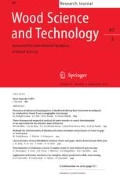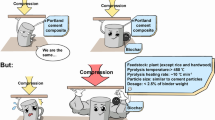Abstract
Phosphate-bonded composites are an emerging class of building materials produced from natural fibres and phosphate based cement pastes. They are durable and possess mechanical properties similar to those of Portland cement. However, the moisture absorption of natural fibre can lead to swelling which may result in the reduction in the mechanical strength properties and eventually negatively affect the long-term performance and dimensional stability of the products. This study was aimed at the modification of some properties of selected biomaterial residues in order to enhance the final properties of the phosphate-bonded composite product. Three different treatments were evaluated viz. 1% caustic alkali, 1% acetic anhydride and hot water on natural fibres derived from slash pine, black wattle and bagasse. The effect of the treatment on the fibres was evaluated via HPLC, SEM and FTIR. Further, the performance of the treated fibres was evaluated in composite panels bonded with magnesium phosphate (MgPO4) and calcium phosphate (CaPO4) cement pastes against the controls. The manufactured panels were tested for flexural properties and dimensional stability. In the MgPO4-bonded panels, the MOR increased from 0.55 MPa for untreated bagasse panels to 0.79 MPa for alkalised panels. Similarly, the MOE increased from 150.04 MPa for untreated bagasse panels to 175.65 MPa for alkalised panels. In untreated MgPO4-bonded panels, the mean density was 0.76, 078 and 0.75 g/cm3, while in alkalised panels, the mean density was 0.81, 0.81 and 0.81 g/cm3 for wattle, pine and bagasse panels, respectively. In the bagasse panels, the water absorption was 54.61% for untreated, 48.74% for hot water extracted, 42.21% for acetylated and 36.44% for alkalised MgPO4-bonded panels. This represents a percentage improvement of 11, 23 and 33%, respectively. Alkali-treated fibres had the best effect overall for all measured properties.















Similar content being viewed by others
References
Abdelmouleh M, Boufi S, Belgacem MN, Dufresne A (2007) Short natural-fibre reinforced polyethylene and natural rubber composites: effect of silane coupling agents and fibres loading. Compos Sci Technol 67(7–8):1627–1639
Amiandamhen SO, Meincken M, Tyhoda L (2016) Magnesium based phosphate cement binder for composite panels: a response surface methodology for optimisation of processing variables in boards produced from agricultural and wood processing industrial residues. Ind Crops Prod 94:746–754
Amiandamhen SO, Meincken M, Tyhoda L (2017) Calcium phosphate bonded wood and fibre composite panels: production and optimization of panel properties. Holzforschung. https://doi.org/10.1515/hf-2016-0199
ASTM (2013) ASTM D1037-13 Standard test methods for evaluating properties of wood-base fiber and particle. Annual book of ASTM Standards. ASTM International, West Conshohocken. https://doi.org/10.1520/D1037-06A.1.2
Beckermann GW, Pickering KL (2008) Engineering and evaluation of hemp fibre reinforced polypropylene composites: fibre treatment and matrix modification. Compos A Appl Sci Manuf 39(6):979–988
Bledzki AK, Mamun AA, Lucka-Gabor M, Gutowski VS (2008) The effects of acetylation on properties of flax fibre and its polypropylene composites. Express Polym Lett 2(6):413–422
Boonstra MJ, Pizzi A, Ohlmeyer M, Paul W (2006) The effects of a two stage heat treatment process on the properties of particleboard. Holz Roh Werkst 64(2):157–164
EN 634-2 (2007) Cement-bonded particleboards-specifications, part 2: requirements for OPC bonded particleboards for use in dry, humid and external conditions. European Standard, London, p 634
Evans PD, Morrison O, Senden TJ, Vollmer S, Roberts RJ, Limaye A, Arns CH, Averdunk H, Lowe A, Knackstedt MA (2010) Visualization and numerical analysis of adhesive distribution in particleboard using X-ray micro-computed tomography. Int J Adhes Adhes 30(8):754–762
Ferraz GP, Frear C, Pelaez-Samaniego MR, Englund K (2016) Hot water extraction of anaerobic digested dairy fiber for wood plastic composite manufacturing. BioResources 11(4):8139–8154
Garrote G, Dominguez H, Parajo J (1999) Hydrothermal processing of lignocellulosic materials. Holz Roh Werkst 57(3):191–202
Hajiha H, Sain M, Mei LH (2014) Modification and characterization of hemp and sisal fibers. J Nat Fibers 11(2):144–168
Joffre T, Segerholm K, Persson C, Bardage SL, Luengo Hendriks CL, Isaksson P (2017) Characterization of interfacial stress transfer ability in acetylation-treated wood fibre composites using X-ray microtomography. Ind Crops Prod 95:43–49
Kabir MM, Wang H, Aravinthan T, Cardona F, Lau K-T (2011) Effects of natural fibre surface on composite properties: a review. In: 1st international postgraduate conference on engineering, designing and developing the built environment for sustainable wellbeing (eddBE2011), Brisbane, Australia, 27–29 April 2011, pp 94–99
Kaczmar JW, Pach J, Burgstaller C (2011) The chemically treated hemp fibres to reinforce polymers. Polimery/Polymers 56(11–12):817–822
Kamke FA, Nairn JA, Muszynski L, Paris JL, Schwarzkopf M, Xiao X (2014) Methodology for micromechanical analysis of wood adhesive bonds using X-ray computed tomography and numerical modeling. Wood Fiber Sci 46(1):15–28
Kanungo D, Francis RC, Shin N-H (2009) Mechanistic differences between kraft and soda/AQ pulping. Part 2: Results from lignin model compounds. J Wood Chem Technol 29(3):227–240
Karade SR, Irle M, Maher K (2003) Assessment of wood-cement compatibility: a new approach. Holzforschung 57:672–680
Kobayashi N, Okada N, Hirakawa A, Sato T, Kobayashi J, Hatano S, Itaya Y, Mori S (2009) Characteristics of solid residues obtained from hot-compressed-water treatment of woody biomass. Ind Eng Chem Res 48(1):373–379
Le Troedec M, Sedan D, Peyratout C, Bonnet JP, Smith A, Guinebretiere R, Gloaguen V, Krausz P (2008) Influence of various chemical treatments on the composition and structure of hemp fibres. Compos A Appl Sci Manuf 39(3):514–522
Li X, Tabil LG, Panigrahi S (2007) Chemical treatments of natural fiber for use in natural fiber-reinforced composites: a review. J Polym Environ 15:25–33
Liu W, Mohanty AK, Askeland P, Drzal LT, Misra M (2004) Influence of fiber surface treatment on properties of Indian grass fiber reinforced soy protein based biocomposites. Polymer 45(22):7589–7596
Loxton C, Thumm A, Grigsby WJ, Adams TA, Ede RM (2003) Resin distribution in medium density fiberboard. Quantification of UF resin distribution on blowline- and dry-blended MDF fiber and panels. Wood Fiber Sci 35(3):370–380
Mohanty AK, Misra M, Drzal LT (2005) Natural fibers, biopolymers, and biocomposites, 1st edn. CRC Press, Boca Raton, p 896. https://doi.org/10.1201/9780203508206
Oladele IO, Olajide JL, Ogunbadejo AS (2015) The influence of chemical treatment on the mechanical behaviour of animal fibre-reinforced high density polyethylene composites. Am J Eng Res 4(2):19–26
Papadopoulou E, Bikiaris D, Chrysafis K, Wladyka-Przybylak M, Wesolek D, Mankowski J, Kolodziej J, Baraniecki P, Bujnowicz K, Gronberg V (2015) Value-added industrial products from bast fiber crops. Ind Crops Prod 68:116–125
Pelaez-Samaniego MR, Yadama V, Lowell E, Espinoza-Herrera R (2013) A review of wood thermal pretreatments to improve wood composite properties. Wood Sci Technol 47(6):1285–1319
Pelaez-Samaniego MR, Yadama V, Garcia-Perez T, Lowell E, Amidon T (2014) Effect of hot water extracted hardwood and softwood chips on particleboard properties. Holzforschung 68(7):807–815
Pickering KL, Beckermann GW, Alam SN, Foreman NJ (2007) Optimising industrial hemp fibre for composites. Compos A Appl Sci Manuf 38(2):461–468
Sawpan MA, Pickering KL, Fernyhough A (2011) Effect of various chemical treatments on the fibre structure and tensile properties of industrial hemp fibres. Compos A Appl Sci Manuf 42(8):888–895
Sgriccia N, Hawley MC, Misra M (2008) Characterization of natural fiber surfaces and natural fiber composites. Compos A Appl Sci Manuf 39(10):1632–1637
Sluiter A, Hames B, Ruiz R, Scarlata C, Sluiter J, Templeton D, Crocker D (2012) NREL/TP-510-42618 analytical procedure—determination of structural carbohydrates and lignin in biomass. Laboratory Analytical Procedure (LAP) (April 2008), p 17
TAPPI T211 (2004) 211 om-02; Ash in wood, pulp, paper and paperboard: combustion at 525 C. TAPPI Test Methods 2005:3–6
Thovert JF, Yousefian F, Spanne P, Jacquin CG, Adler PM (2001) Grain reconstruction of porous media: application to a low-porosity Fontainebleau sandstone. Phys Rev E Stat Nonlinear Soft Matter Phys 63(6I):061307/1–061307/11. https://doi.org/10.1103/physreve.63.061307
Tserki V, Zafeiropoulos NE, Simon F, Panayiotou C (2005) A study of the effect of acetylation and propionylation surface treatments on natural fibres. Compos A Appl Sci Manuf 36(8):1110–1118
Vena PF, Görgens JF, Rypstra T (2010) Hemicelluloses extraction from giant bamboo prior to kraft and soda aq pulping to produce paper pulps, value-added biopolymers and bioethanol. Cell Chem Technol 44(4–6):153–163
Wagh AS (2004) Chemically bonded phosphate ceramics, 1st edn. Elsevier, Amsterdam, p 304. ISBN 9780080455679
Wang Y, Muszynski L, Simonsen J (2007) Gold as an X-ray CT scanning contrast agent: effect on the mechanical properties of wood plastic composites. Holzforschung 61(6):723–730
Acknowledgements
The authors thank the National Research Foundation, South Africa for financial support (Grant No. 88598). We also acknowledge Cape Pine, TSB Sugar Ltd., and EC Biomass for material supplies.
Author information
Authors and Affiliations
Corresponding author
Rights and permissions
About this article
Cite this article
Amiandamhen, S.O., Meincken, M. & Tyhoda, L. The effect of chemical treatments of natural fibres on the properties of phosphate-bonded composite products. Wood Sci Technol 52, 653–675 (2018). https://doi.org/10.1007/s00226-018-0999-9
Received:
Published:
Issue Date:
DOI: https://doi.org/10.1007/s00226-018-0999-9




